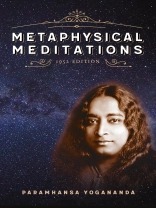Metaphysical Meditations
The reprint of the original 1952 edition
By Paramhansa Yogananda
Most people want to meditate but do not know how to do so. The purpose of meditation is to connect the little joy of the soul with the vast joy of the Spirit with focused practice.
Meditation is not the same as concentration which consists in freeing the attention from objects of distraction and focusing on one thing at a time. Meditation is that special form of concentration in which the attention has been liberated from restlessness, and is focused on the Infinite, to be focused only on God or sacred thoughts and ideas.
Meditation consists in certain physical, psychological, and metaphysical processes—by which the static of restlessness can be removed from the body, mind, and soul radios, which can then be tuned in with the Infinite. By calm, continuous, one pointed attention the ego must be kept connected to the Spirit until they both become merged into everlasting bliss.
In Metaphysical Meditations Paramhansa Yogananda, author of the best-selling spiritual classic Autobiography of a Yogi, gives some concrete metaphysical methods of meditation, for the student who has already struggled through the mobs of rowdy thoughts and crossed the portals of silence. The instructions will be found in the various sections of the book preceding each type of meditation: prayers or demands addressed to the Divine, affirmations about God, and those spoken to the individual consciousness.
Jadual kandungan
Contents to Metaphysical Meditations
Foreword vii
Devotion & Worship 1
Meditations: To God 17
Expansion of Consciousness 33
On Finding God 49
On Material Concerns 65
On Self Improvement 85
Special Christmas Meditations 107
About the Author117
Further Explorations 119
Mengenai Pengarang
Paramhansa Yogananda Born in 1893, Yogananda was the first yoga master of India to take up permanent residence in the West.Yogananda arrived in America in 1920 and traveled throughout the country on what he called his “spiritual campaigns.” Hundreds of thousands filled the largest halls in major cities to see the yoga master from India. Yogananda continued to lecture and write up to his passing in 1952.Yogananda’s initial impact on Western culture was truly impressive. His lasting spiritual legacy has been even greater. His Autobiography of a Yogi, first published in 1946, helped launch a spiritual revolution in the West. Translated into more than fifty languages, it remains a best-selling spiritual classic to this day.Before embarking on his mission, Yogananda received this admonition from his teacher, Swami Sri Yukteswar: “The West is high in material attainments but lacking in spiritual understanding. It is God’s will that you play a role in teaching mankind the value of balancing the material with an inner, spiritual life.”In addition to Autobiography of a Yogi, Yogananda’s spiritual legacy includes music, poetry, and extensive commentaries on the Bhagavad Gita, the Rubaiyat of Omar Khayyam, and the Christian Bible, showing the principles of Self-realization as the unifying truth underlying all true religions. Through his teachings and his Kriya Yoga path millions of people around the world have found a new way to connect personally with God.His mission, however, was far broader than all this. It was to help usher the whole world into Dwapara Yuga, the new Age of Energy in which we live. “Someday, ” Swami Kriyananda wrote, “I believe he will be seen as the avatar of Dwapara Yuga: the way shower for a new age.”







![perlindungan daripada Brian Schrag & Julisa Rowe: Community Arts for God's Purposes [Chinese] 貼近神心意的社群藝術 perlindungan daripada Brian Schrag & Julisa Rowe: Community Arts for God's Purposes [Chinese] 貼近神心意的社群藝術](https://static.worldofdigitals.com/thumb_webp/740/9781645083740.webp)




